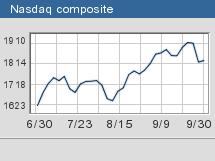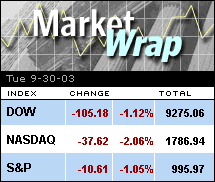NEW YORK (CNN/Money) -
U.S. stocks closed lower on the day and on the month Tuesday, with a technology selloff pacing a broader decline, following an earnings warning from Sun Microsystems and a pair of weak economic reports.

Despite September's weak finish, stocks closed the quarter with strong gains, most notably in the technology sector.
"We did OK for the first half of the month and then faded out -- a lot of the economic data in the last few weeks have been a little discouraging," said Donald Selkin, director of research at Joseph Stevens. "It's kind of a sour way to end a good quarter but not too bad for the month."
Traditionally, September is a terrible month for stocks. According to the Hirsch Organization, which publishes the Stock Trader's Almanac, September has been the worst month for the Dow and S&P 500 for the last 52 years. Because of the historic trend, for the major indexes to close the month just modestly lower is a relatively impressive showing, analysts said.
In September, the Nasdaq lost 1.2 percent, the Dow lost 1.3 percent, and the S&P 500 lost 1.2 percent.

Most of those declines were due to a selloff last week and on Tuesday.
On Tuesday, the Nasdaq composite (down 37.62 to 1786.94, Charts) lost about 2 percent. The Dow Jones industrial average (down 105.18 to 9275.06, Charts) lost some 1.1 percent on the day, while the Standard & Poor's 500 (down 10.61 to 995.97, Charts) index lost about 1 percent. All three major indexes had been even lower in the morning.
For the quarter, the Nasdaq gained 10.1 percent, the Dow gained 3.2 percent, and the S&P 500 gained 2.2 percent.
Selkin said that stocks are likely to drift for the next week or so until the financial reporting period begins. But if history is a guide, often stocks will bottom in mid-October and then start moving higher by the end of the month.

Among the factors influencing trade Wednesday: the September read on manufacturing from the Institute for Supply Management, which will be of keen interest following Tuesday's weak regional manufacturing number. The report is due 30 minutes after trading begins and is expected to show a rise to 55.0 from 54.7 in August, according to economists surveyed by Briefing.com.
Due around the same time is the construction spending report for August, expected to show a rise to 0.4 percent from 0.2 percent last month.
Tuesday's market
Sun Microsystems (SUNW: down $0.55 to $3.31, Research, Estimates) issued a warning late Monday that its fiscal first-quarter loss will be much bigger than had been expected, and that it will take a $1 billion charge as its business continues to struggle. The news sent its shares 14.25 percent lower and had a similar, although milder impact on a variety of technology issues.
Adding to the pressure was news that both the monthly Chicago Purchasing Managers' index, a snapshot of regional manufacturing activity, and the consumer confidence report, dropped from the previous month and failed to meet economists' estimates.
Among individual issues, technology shares led the decliners, as they have throughout the occasional pullbacks in the many months of the rally.
Although Sun's problems are not news to the market and its warning could hardly be seen as a sign of trouble for the broader technology sector, investors used Sun's situation as an excuse to dump high-tech shares, which had been the leaders in the rally. All of the Dow industrials' technology components -- Hewlett-Packard (HPQ: down $0.26 to $19.36, Research, Estimates), IBM (IBM: down $1.12 to $88.33, Research, Estimates), Intel (INTC: down $0.85 to $27.52, Research, Estimates), and Microsoft (MSFT: down $1.03 to $27.80, Research, Estimates) -- sold off.
Adding to the tech troubles, Enterasys Networks (ETS: down $1.70 to $4.00, Research, Estimates) shares fell 30 percent in unusually active NYSE trade after the communications gear maker said it expects third-quarter revenue to fall 8-to-13 percent from the second quarter because some customers are delaying purchasing decisions.
Shares of Dow stock Alcoa (AA: down $1.20 to $26.16, Research, Estimates) fell 4.4 percent after brokerage UBS Warburg reiterated its "reduce" rating on the stock and said it thinks the company's earnings will be short of estimates when the aluminum producer reports results next week, due to seasonal weakness in certain international markets, among other factors.
The Chicago Purchasing Managers' index, a measure of manufacturing activity in that region, came in at a much-lower-than-forecast 51.2 in September, compared with 58.9 in August. Although a reading above 50 still indicates an expanding manufacturing sector, the report showed that activity has slowed down considerably from the previous month and was a surprise to economists who had expected the index to come in at 57.
The Chicago PMI is a precursor to the national reading on manufacturing, which is due Wednesday.
Adding to the gloom, the Conference Board said concerns about a struggling labor market led to a fall in its consumer confidence index to 76.8 in September from a revised 81.7 in August. Economists had expected a much smaller decline to 80.5.
The U.S. consumer's resilience through the recession and nearly two years of a barely-there recovery has been a source of optimism on Wall Street. Signs that consumers are starting to give up, even as economic growth is picking up, added to investors' concerns that the rally, which started in March, already has left stocks overvalued.
"The two reports don't constitute a change of direction for the economy, but they are negative enough to make investors feel more cautious about the recovery," said Peter Cardillo, director of research at Global Partners Securities.
Meanwhile, the dollar recovered from its overnight slide that took it to a three-year low against the yen. However, the greenback remained weaker versus the euro.
Market breadth was mixed. Gainers and losers were evenly split on the New York Stock Exchange, where almost 1.5 billion shares traded. On the Nasdaq, decliners beat advancers by three to two as nearly 1.84 billion shares changed hands.
Treasury prices rallied and yields came down sharply after the two weak economic readings and amid the stock market's drop. The 10-year note climbed 1-2/32 points in price, its yield falling to 3.94 percent, a 10-week low, from 4.07 percent late Monday.
NYMEX light sweet crude oil futures gained 80 cents to settle at $29.20 a barrel. COMEX gold rallied $2.90 to settle at $386.10 an ounce.

|

